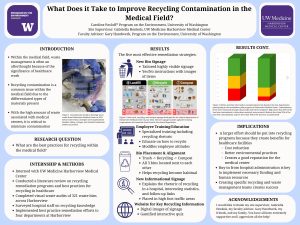What does it Take to Improve Recycling Contamination in the Medical Field?
In a society where the population continues to rise and therefore more resources are being used, recycling is a key tool to minimize waste and includes benefits for the environment, public health, and the economy. In order to eliminate waste effectively, proper recycling practices are critical. Within the medical field, waste management is often an afterthought because of the significance of healthcare work. Recycling contamination is unfortunately a common issue within the medical field due to the differentiated types of materials present that can be potentially hazardous. Another common cause of recycling contamination includes improper waste disposal and sorting habits. The purpose of this study was to find the best strategies to eliminate recycling contamination within the medical field in order to boost sustainable practices. To accomplish this task, I completed visual waste audits at UW Medicine Harborview Medical Center to understand the severity of recycling contamination present. From there, I conducted literature reviews and surveys of hospital staff in order to discover what would work best at Harborview to minimize recycling contamination as much as possible. Findings demonstrated that increased signage, proper bin placement education and training of employees, implementing additional informational signage, and creating a recycling tool kit were all effective strategies in minimizing recycling contamination. Through implementing these strategies, medical centers can increase cost savings, improve environmental practices, and create an overall good reputation for the medical center.
